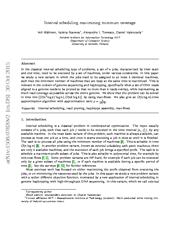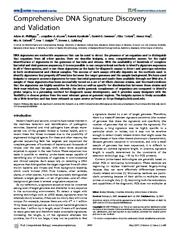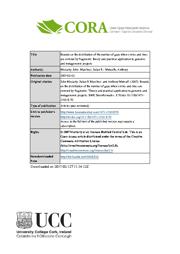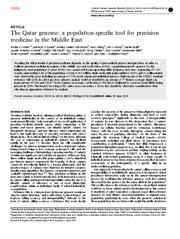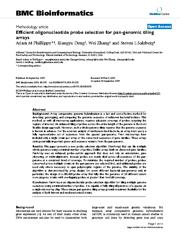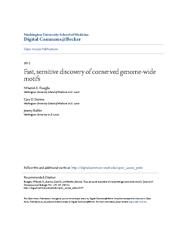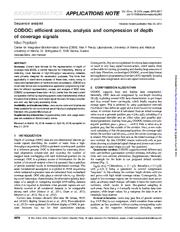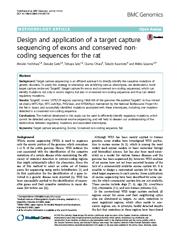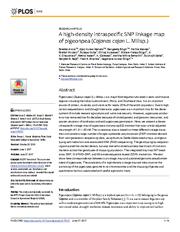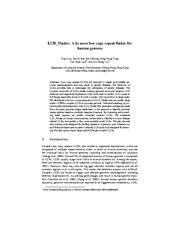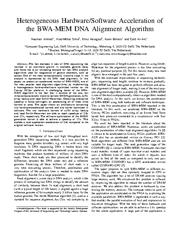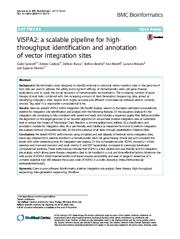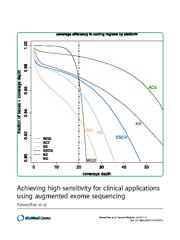A copy of this work was available on the public web and has been preserved in the Wayback Machine. The capture dates from 2019; you can also visit the original URL.
The file type is application/pdf.
Filters
Interval scheduling maximizing minimum coverage
[article]
2015
arXiv
pre-print
This is relevant in the context of genome sequencing and haplotyping, specifically when a set of DNA reads aligned to a genome needs to be pruned so that no more than k reads overlap, while maintaining ...
In the classical interval scheduling type of problems, a set of n jobs, characterized by their start and end time, need to be executed by a set of machines, under various constraints. ...
This work was partially supported by the Academy of Finland grants 284598 to VM, VS, and DV, and 274977 to AT. ...
arXiv:1508.07820v2
fatcat:ehootxz4vvdwrpx4xvcojey2p4
Comprehensive DNA Signature Discovery and Validation
2007
PLoS Computational Biology
With the availability of hundreds of complete bacterial and viral genome sequences, it is now possible to use computational methods to identify signature sequences in all of these species, and to use these ...
Our approach, whereby the entire genomic complement of organisms are compared to identify probe targets, is a promising method for diagnostic assay development, and it provides assay designers with the ...
AMP, KA, and SLS designed Insignia. DDS tested Insignia and managed the computing cluster. JAM and ITK designed and performed the validation experiments. ...
doi:10.1371/journal.pcbi.0030098
pmid:17511514
pmcid:PMC1868776
fatcat:com2madqirex7belcn6dlmpzz4
Comprehensive DNA Signature Discovery and Validation
2005
PLoS Computational Biology
With the availability of hundreds of complete bacterial and viral genome sequences, it is now possible to use computational methods to identify signature sequences in all of these species, and to use these ...
Our approach, whereby the entire genomic complement of organisms are compared to identify probe targets, is a promising method for diagnostic assay development, and it provides assay designers with the ...
AMP, KA, and SLS designed Insignia. DDS tested Insignia and managed the computing cluster. JAM and ITK designed and performed the validation experiments. ...
doi:10.1371/journal.pcbi.0030098.eor
fatcat:eo3qlqzxnzhtjlzcffwldmnohm
Bounds on the distribution of the number of gaps when circles and lines are covered by fragments: Theory and practical application to genomic and metagenomic projects
2007
BMC Bioinformatics
The method can be applied to coverage problems on the interval, including edge effects, and applications are given to metagenomic libraries and shotgun sequencing. ...
Bounds on the distribution of the number of gaps when circles and lines are covered by fragments: Theory and practical application to genomic and metagenomic projects. ...
The authors would like to thank Andrew Haugh for providing numerical simulations during this project and Professor Armand Makowski for the seminar which was its inspiration, and the reviewers for their ...
doi:10.1186/1471-2105-8-70
pmid:17335566
pmcid:PMC1821341
fatcat:euel2hpmg5c2rm32szvlng3vi4
The Qatar genome: a population-specific tool for precision medicine in the Middle East
2016
Human Genome Variation
In order to facilitate precision medicine in regions of the Middle East and North Africa (MENA), a population-specific reference genome for the indigenous Arab popula-tion of Qatar (QTRG) was constructed ...
by incorporating allele frequency data from sequencing of 1,161 Qataris, representing 0.4% of the population. ...
ACKNOWLEDGEMENTS We thank 1000 Genomes Project collaborators, as well as colleagues in the American Society of Human Genetics and the Society for Molecular Biology and Evolution for valuable discussion ...
doi:10.1038/hgv.2016.16
pmid:27408750
pmcid:PMC4927697
fatcat:lunpknl77vffjai2epiibwb6fu
Efficient oligonucleotide probe selection for pan-genomic tiling arrays
2009
BMC Bioinformatics
Array comparative genomic hybridization is a fast and cost-effective method for detecting, genotyping, and comparing the genomic sequence of unknown bacterial isolates. ...
To minimize the required number of probes, probes conserved across multiple strains in the pan-genome are selected first, and additional probes are used only where necessary to span polymorphic regions ...
Acknowledgements The authors would like to thank Arthur Delcher for a helpful critique of the manuscript draft, and Hervé Tettelin and David Riley for help running their pan-genome analysis software. ...
doi:10.1186/1471-2105-10-293
pmid:19758451
pmcid:PMC2753849
fatcat:xdbptietqfci7kcbv4lujlvvxq
Fast, Sensitive Discovery of Conserved Genome-Wide Motifs
2012
Journal of Computational Biology
We obtained 2,309 motifs with lengths of 6-20 bp, each occurring at least 10 times throughout the genome, which collectively covered about 566 kbp of the genomes, approximately 0.8% of the input. ...
ABSTRACT Regulatory sites that control gene expression are essential to the proper functioning of cells, and identifying them is critical for modeling regulatory networks. ...
Funding was provided by NIH (grant HG00249 to G.D.S.) and NSF (grant ITR-427794 to J.B.). ...
doi:10.1089/cmb.2011.0249
pmid:22300316
pmcid:PMC3272693
fatcat:ttu5x7zhmbd2fbpegzqaploblq
DETECTION OF BACTERIAL SMALL TRANSCRIPTS FROM RNA-SEQ DATA: A COMPARATIVE ASSESSMENT
2016
Pacific Symposium on Biocomputing. Pacific Symposium on Biocomputing
In the last decade, next generation RNA sequencing (RNA-seq) has been used for the genome-wide detection of bacterial sRNAs. ...
Using RNA-seq data from three bacterial species and two sequencing platforms, we performed a comparative assessment of five computational approaches for the detection of small transcripts. ...
Acknowledgements LPC's and ASL's research programs are supported by NSERC Discovery grants. MG is supported by a fellowship of Memorial University's School of Graduate Studies. ...
pmid:26776209
fatcat:ireea6mganesza7zbs5wbnicgy
CODOC: efficient access, analysis and compression of depth of coverage signals
2014
Computer applications in the biosciences : CABIOS
This limits their applicability in stand-alone analyses of these data, mainly owing to inaccurate representation or mediocre data compression. ...
CODOC is a novel data format and comprehensive application programming interface for efficient representation, access and analysis of DOC data. ...
ACKNOWLEDGEMENTS The author thanks Stefan Leitich for helpful discussions about audio compression methods and several CIBIV colleagues and the reviewers for critically reading the manuscript. ...
doi:10.1093/bioinformatics/btu362
pmid:24872424
fatcat:c62vhdhkkjhupjxkcyalmkrjyi
Design and application of a target capture sequencing of exons and conserved non-coding sequences for the rat
2016
BMC Genomics
Results: TargetEC covers 1,078,129 regions spanning 146.8 Mb of the genome. ...
To apply this strategy to laboratory rats exhibiting various phenotypes, we developed a novel target capture probe set, TargetEC (target capture for exons and conserved non-coding sequences), which can ...
Acknowledgements We are thankful to the National BioResource Project -Rat (http://www.anim.med. kyoto-u.ac.jp/nbr/) for providing rat strains (WTC/Kyo, WTC-swh/Kyo, PVG/Seac, and KFRS4/Kyo). ...
doi:10.1186/s12864-016-2975-9
pmid:27506932
pmcid:PMC4979189
fatcat:at3caznowvgubcnoemgwvncady
A high-density intraspecific SNP linkage map of pigeonpea (Cajanas cajan L. Millsp.)
2017
PLoS ONE
The availability of a high-density linkage map will help improve the anchoring of the pigeonpea genome to its chromosomes and the mapping of genes and quantitative trait loci associated with useful agronomic ...
It is an important source of protein, minerals, and vitamins for nearly 20% of the world population. ...
Acknowledgments We gratefully acknowledge the financial and infrastructural support of Indian Council of Agricultural Research (ICAR).
Author Contributions Conceptualization: Nagendra Kumar Singh. ...
doi:10.1371/journal.pone.0179747
pmid:28654689
pmcid:PMC5487049
fatcat:thsvwzpn7ffclchktha2xzpexm
LCR_Finder: A de Novo Low Copy Repeat Finder for Human Genome
[chapter]
2013
Lecture Notes in Computer Science
Low copy repeats (LCRs) are reported to trigger and mediate genomic rearrangements and may result in genetic diseases. ...
We also showed that existing tools designed for finding repeats in a genome, such RepeatScout and WindowMasker are not able to identify LCRs and tools designed for detecting SDs also cannot report large ...
The minimum interval on reference sequence that covered all alignments in a cluster was calculated for each cluster. Only intervals larger than of L/2were kept (Fig 3B) . ...
doi:10.1007/978-3-642-38036-5_15
fatcat:ev67ttaovnb5pman422bw24use
Heterogeneous hardware/software acceleration of the BWA-MEM DNA alignment algorithm
2015
2015 IEEE/ACM International Conference on Computer-Aided Design (ICCAD)
The fast decrease in cost of DNA sequencing has resulted in an enormous growth in available genome data, and hence led to an increasing demand for fast DNA analysis algorithms used for diagnostics of genetic ...
The software optimization of the SMEM generation kernel is able to achieve a speedup of 1.7x. This enables a total application acceleration of 2.6x compared to the original software version. ...
Acknowledgement-This work is supported by the Faculty Development Program of the University of Engineering and Technology Lahore, Pakistan ...
doi:10.1109/iccad.2015.7372576
dblp:conf/iccad/AhmedSHBA15
fatcat:fxjmxise4jb4ppw4z7zwiu2qaq
VISPA2: a scalable pipeline for high-throughput identification and annotation of vector integration sites
2017
BMC Bioinformatics
therapy applications and to study the clonal dynamics of hematopoietic reconstitution. ...
: (1) the sequence analysis for the integration site processing is fully compliant with paired-end reads and includes a sequence quality filter before and after the alignment on the target genome; (2) ...
Funding This work has been supported by many projects, both international and national funding:
Availability of data and materials ...
doi:10.1186/s12859-017-1937-9
pmid:29178837
pmcid:PMC5702242
fatcat:2lnmc2axmvh2vjzh6e6ijrg5nq
Achieving high-sensitivity for clinical applications using augmented exome sequencing
2015
Genome Medicine
set of ACMG secondary finding genes (91 % covered relative to 4-75 % with other platforms) and a subset of variants known to be associated with human disease (99 % covered relative to 52-95 % with other ...
In clinical applications where comprehensive coverage of medically interpretable areas of the genome requires higher localized sequencing depth, an augmented exome approach offers both cost and performance ...
Conversely, 100× average depth of coverage is commonly referred to as the minimum amount of coverage needed in clinical applications, regardless of the total amount of sequence data obtained. 100× mean ...
doi:10.1186/s13073-015-0197-4
pmid:26269718
pmcid:PMC4534066
fatcat:mlmbzuyzdfgabpkx5ccmpq3rwa
« Previous
Showing results 1 — 15 out of 36,892 results

